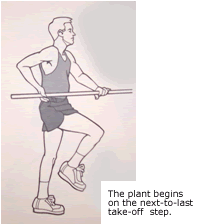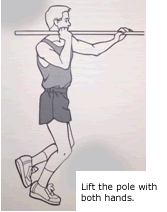The Pole Vault Plant with Bill Falk
NPVCA Curriculum #4
Previous: #3 – Approach Run
Next: #5 – Take-off and Drive Swing
Bill Falk teaches the pole vault plant, probably the most technical part of the pole vault. A proper plant is a transition that converts the Approach Run horizontal motion into a vertical lift-off. From the Come to Pole Vault Practice DVD.
Pole Vault Plant Basic Technique
Importance
The Plant is perhaps the most important link in the pole vault chain. When done correctly, it creates a bridge that is used to convert the horizontal Approach Run into vertical lift-off. When the Plant is not done well, it becomes very difficult to execute later phases of the vault naturally and dynamically. When the vaulter plants the pole correctly, he or she normally will land safely in the pit. A poor Plant causes erratic vaults.
Technical Model
During the Approach Run, the pole tip is gradually lowered until the pole is parallel to the runway, waist high. (See Figure F). The Plant starts as the next-to-last take-off step is about to land. Both hands drive upward, not forward, to smoothly convert horizontal movement to vertical lift.
As the last non-take-off step hits the runway, the top hand drives up to a position close to the ear. The bottom hand also lifts so the pole is kept parallel to the runway about ear high. (See Figure G)

Figure F

Figure G
Do not push the lower hand towards the box! Lift it upward. Keep both elbows underneath the hands. The planting action resembles an upward punch.
The vaulter drives both hands upward and forward during the final step. (See Figure H). The top hand passes just in front of the ear as it moves upward. The lower arm also drives upward. The pole tip lands in the box approximately 2/3 back. As the pole tip slides towards the back of the box, the vaulter continues to drive the top of the pole upward and forward while jumping off the runway. (See Figure I).

Figure H

Figure I
If the Plant is done correctly, the pole tip slides to the back of the box instead of being thrust against it. Pole bending is delayed, and the vaulter and the top of the pole are able to continue moving upward.
Drills
The 3-Step Drill (also called the 1-2-3 Drill) is the best way to teach beginners how to plant the pole. Hold the pole parallel to the runway waist high, and face the pit with feet slightly apart. Assuming the vaulter is right-handed, the step sequence is left, right, left. Lift the pole with both hands while taking the first step and continue to lift it during the next two steps as described above in the Technical Model section. Emphasize the simultaneous lifting and upward extension of the entire body during the entire planting procedure.
Start the beginner with a broomstick, since it is easier to handle than a pole. The coach calls out 1-2-3 to guide the vaulter. Use a slow cadence at first and emphasize good technique.
Have the beginner use a pole and quicken the cadence once he or she attains some proficiency. As the vaulter gets better and better at walking the Plant, call out 1-2-3 fast enough to make the beginner run the sequence. Variations of the 3-Step Drill include planting at the end of a full-speed Approach Run. Vary the length of the Approach Run to get the vaulter used to beginning the Plant at the proper time.
Coaching Points
Maintain good posture throughout the Plant. Frequent mistakes include leaning back, over striding and turning sideways.
Start the Plant on time. The most common mistake made by vaulters during the Plant is starting late and not being able to complete the Plant.
Make sure the vaulter lifts both hands during the Plant. Many athletes lift only their top hand. This will cause the pole tip to hit the back of the box too soon, which makes the pole to bend prematurely.
Previous: #3 – Approach Run
Next: #5 – Take-off and Drive Swing